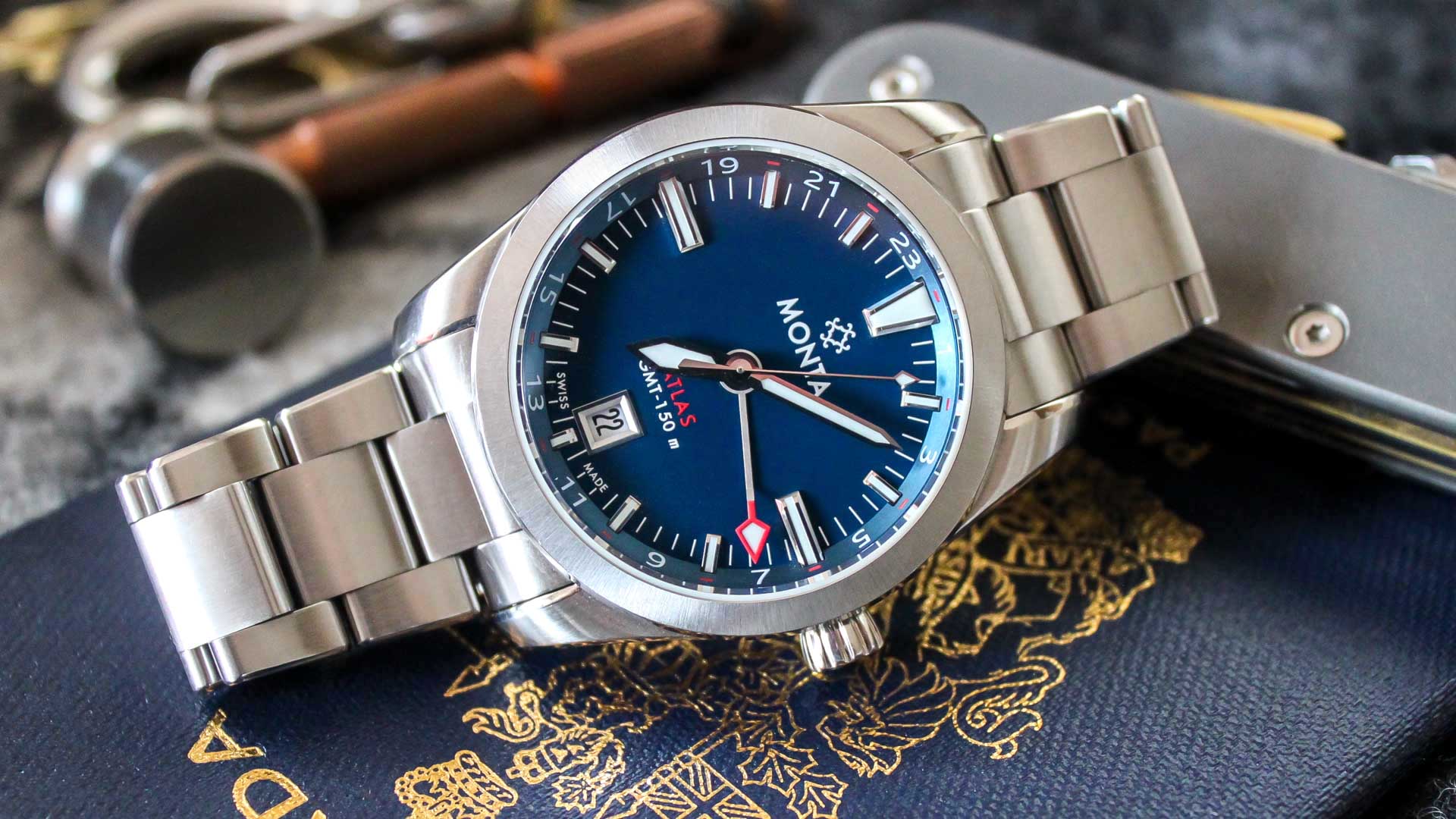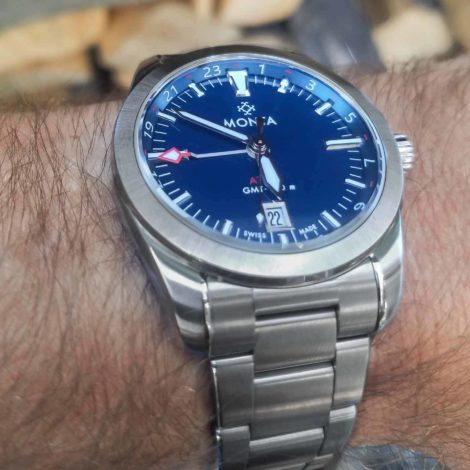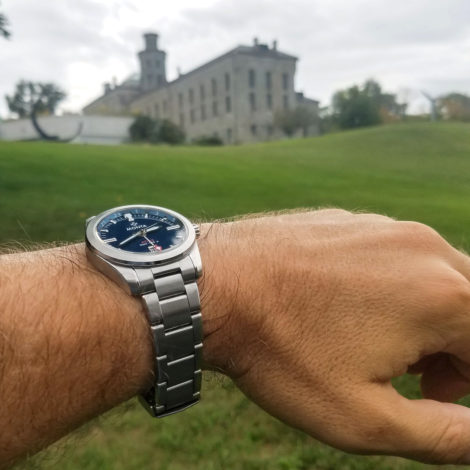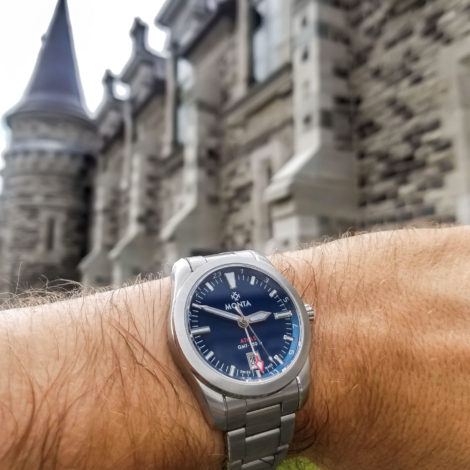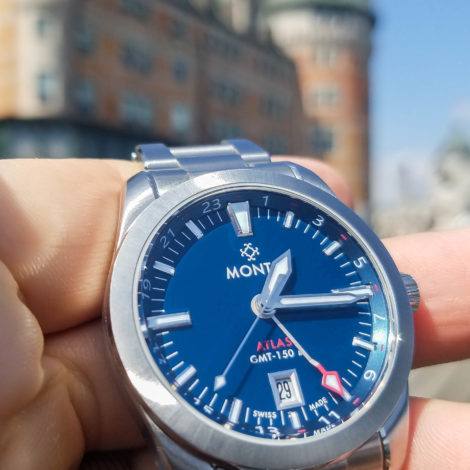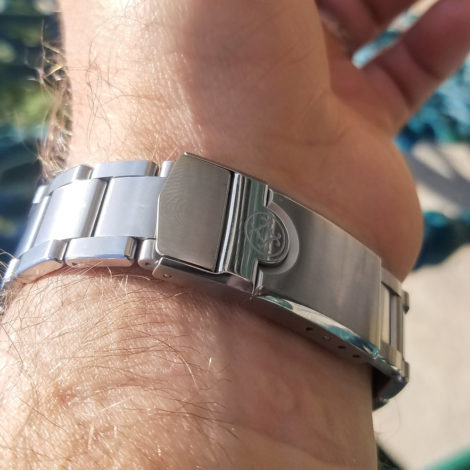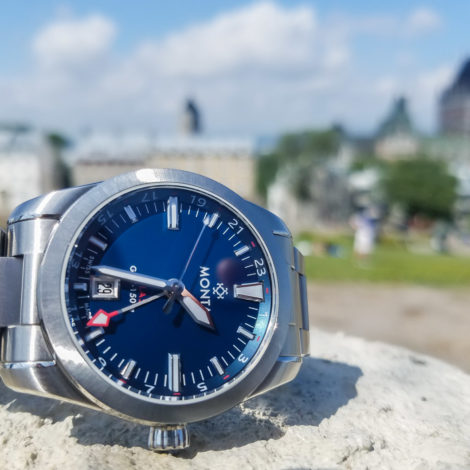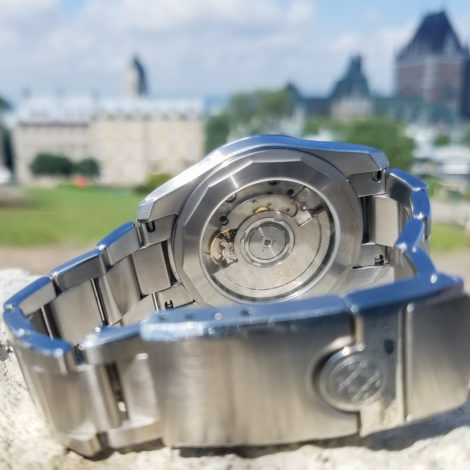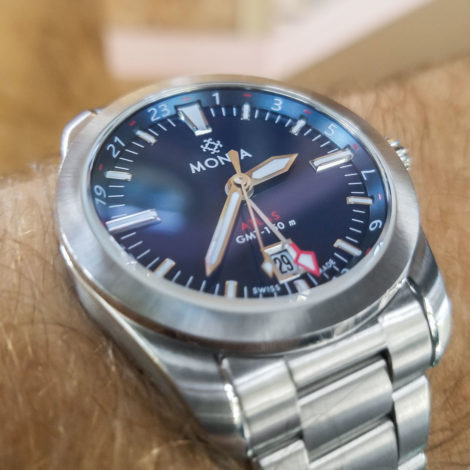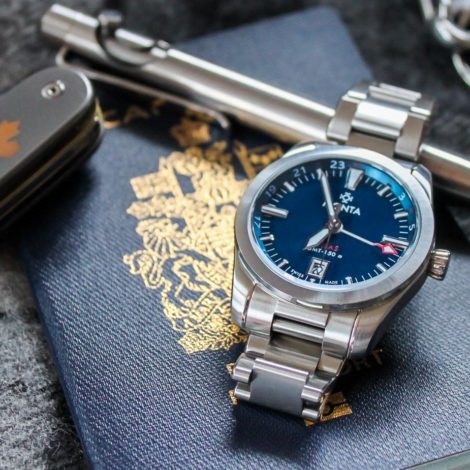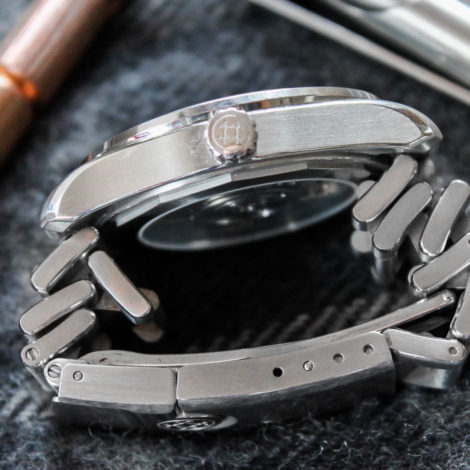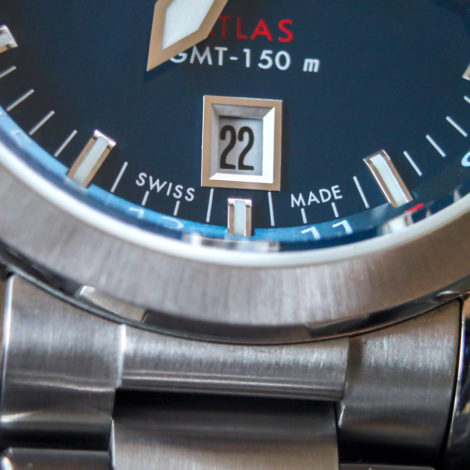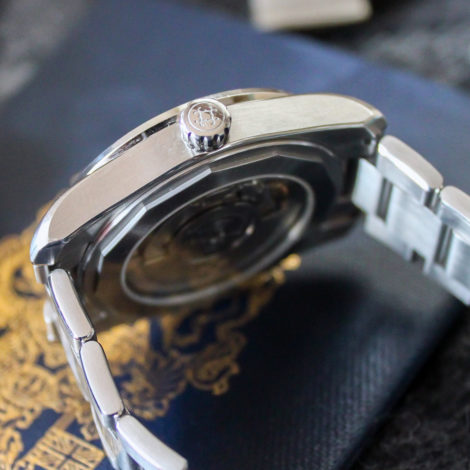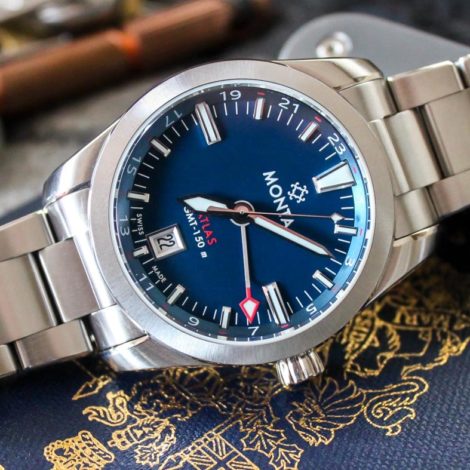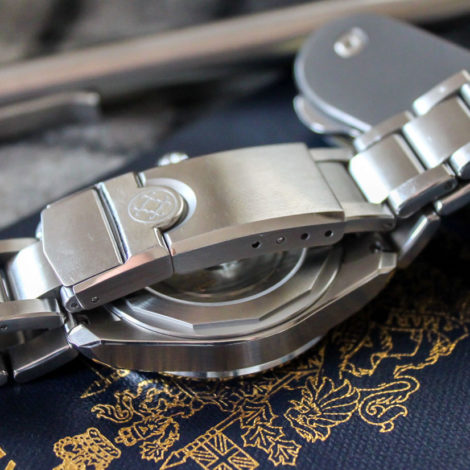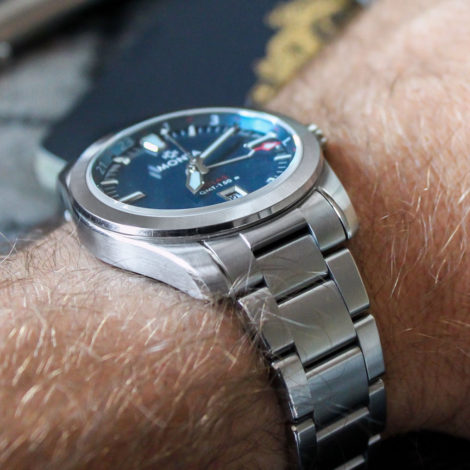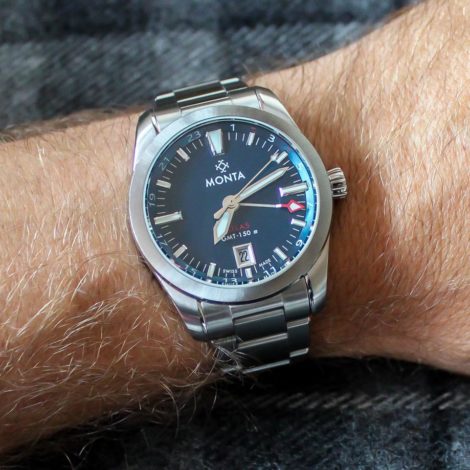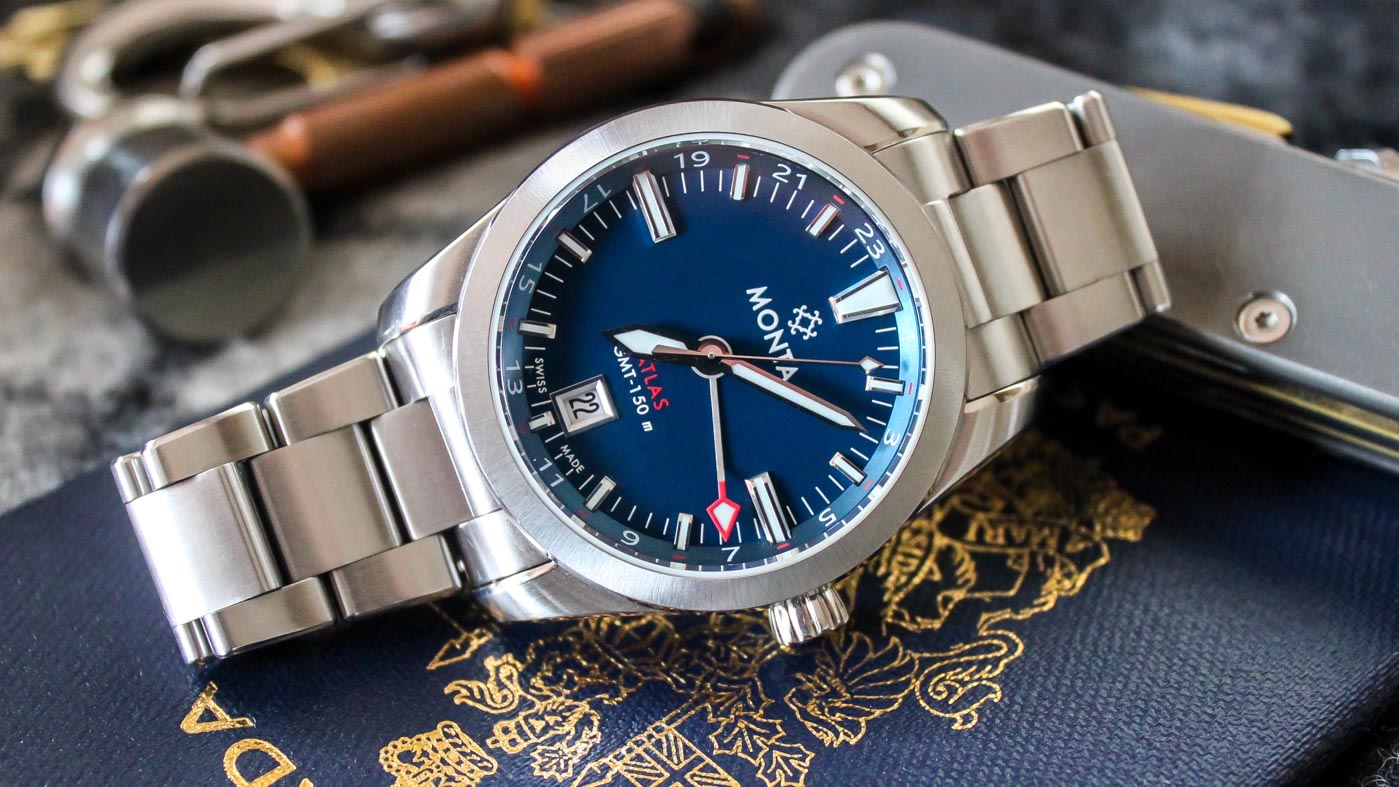
GMT watches have experienced a major surge in popularity over the past couple of years and for good reason — they’re one of the more useful complications out there, especially if you’re a frequent traveler or have reason to keep track of multiple time zones. GMTs add functionality unobtrusively; it’s a complication that’s there when you need it but is easily ignored when you don’t. Plus, even if you’re not traveling, you can always set the GMT hand to somewhere exotic, say Fiji, and take a quick mental escape during work, imagining sunset breezes on the beach during your mid-morning coffee break.
St. Louis-based Monta Watches are clearly fans of the function, considering two of its four current offerings are GMT watches. Since releasing its first watch, the on-hiatus Oceanking, in 2016, Monta have gained a loyal following, with fans of the brand praising the sizing and proportions of their watches, classic styling, and exceptional fit and finish. A while back, I had finally had enough and needed to see what the fuss was all about, and, given that I had some travel coming up, it seemed a perfect time to try out one of the brand’s GMTs. I went with the Monta Atlas, a well-proportioned and classically-styled GMT that was first announced in early 2019. While Monta has continued to iterate and improve on its watches—including the subsequently released Noble, a complete overhaul of the Skyquest, and an upcoming overhaul of the original Ocenanking—the Atlas remains in its lineup, virtually unchanged since its debut.
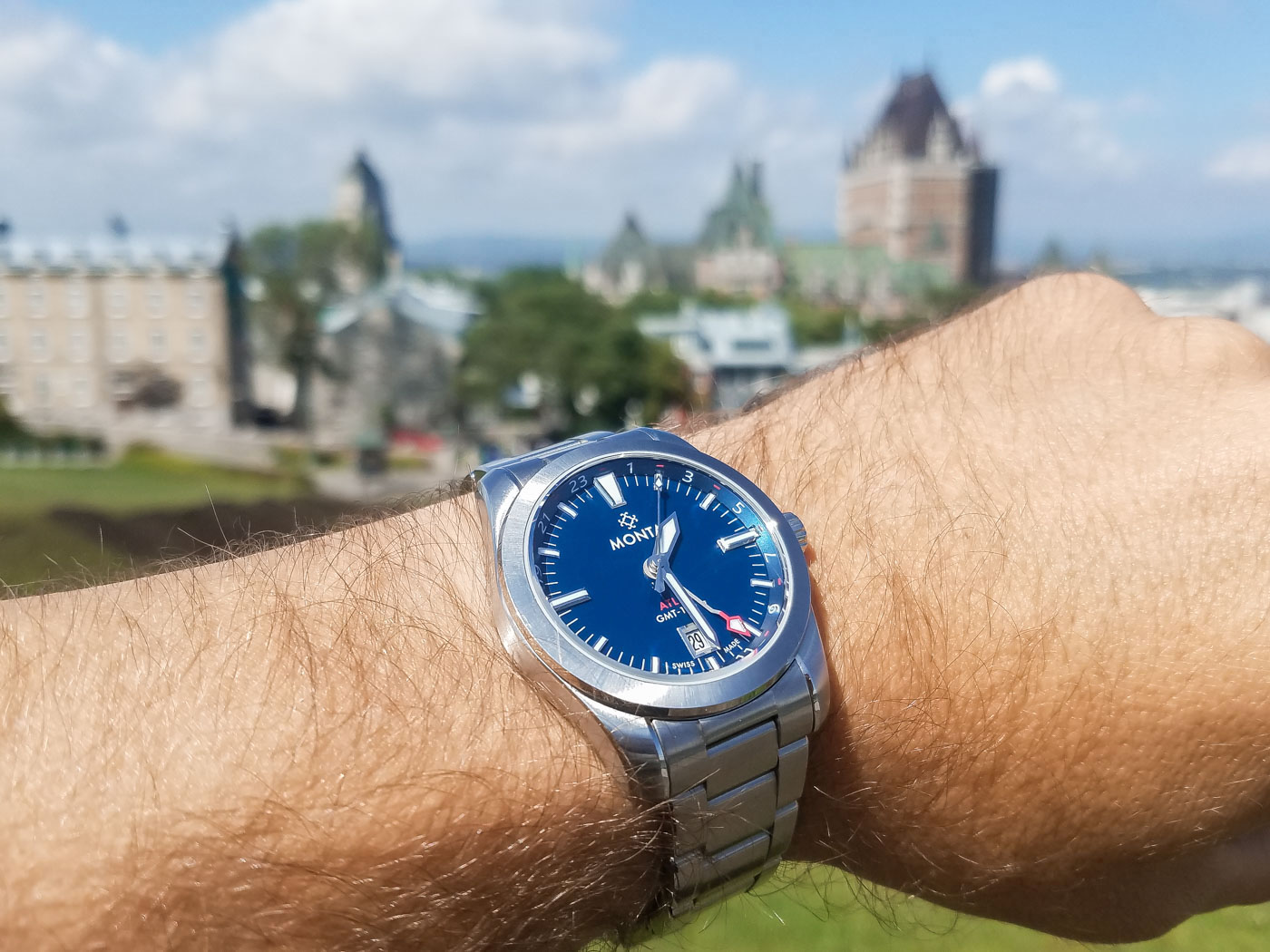
Anytime a watch shows up in the mail, I open the box with a general set of expectations formed from press releases, shiny Instagram photos, or other media coverage. I don’t tend to get too hyped up, as I’m sure many of you can relate to the experience of being let down after opening a box and realizing that this Platonic ideal of a watch you built up in your head doesn’t live up to the actual product. So, at this point, I’m pretty tempered in my expectations and more interested in seeing how I bond with the watch over a period of weeks or months, rather than how I react on first seeing the watch.
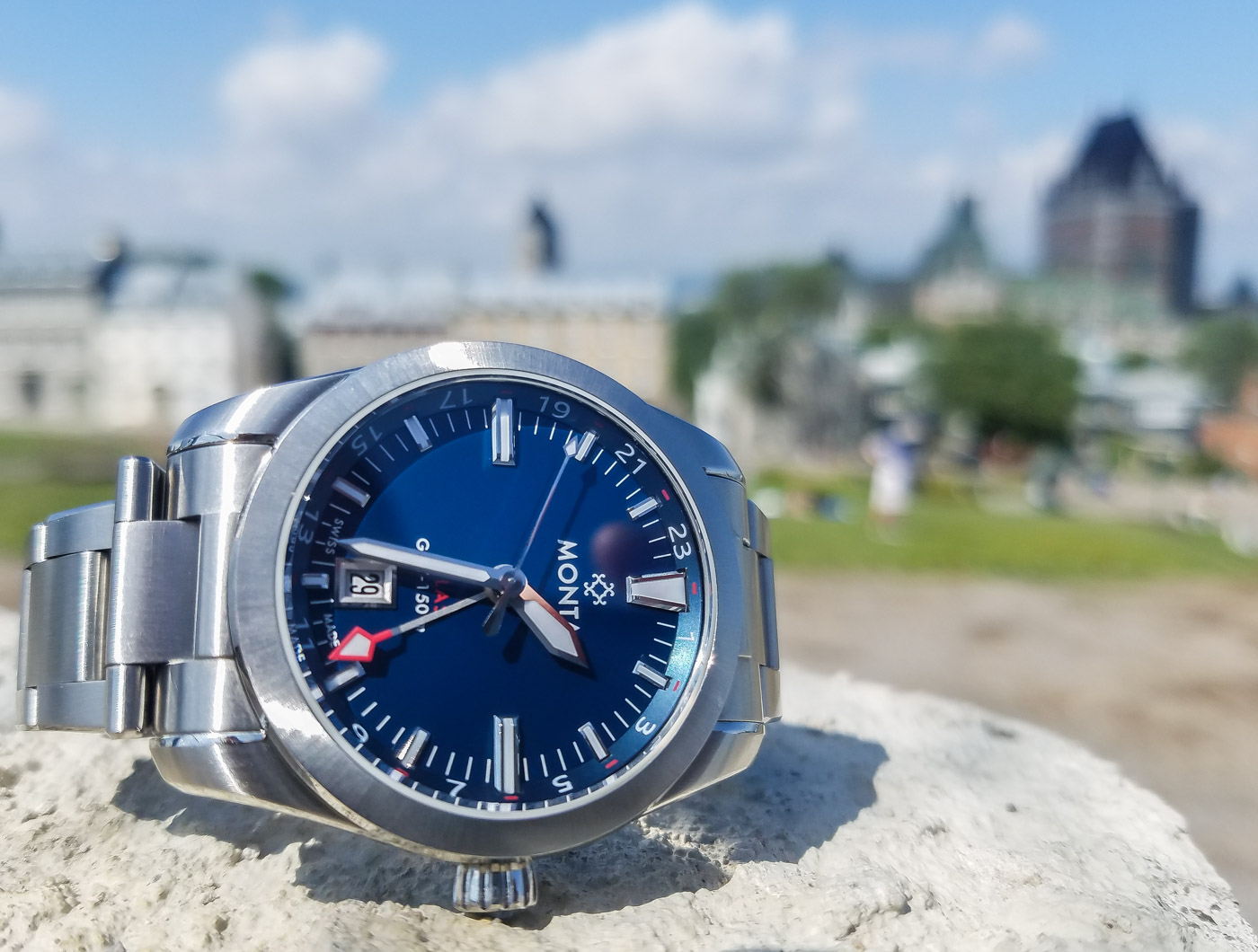
When I opened the box containing the Monta Atlas, though, my typical even-keeled approach to receiving review pieces was promptly defenestrated. I knew Monta produced nice watches, and word on the street was that they’re comfortable and well-finished. So, sure, I expected to see a nice watch (and at nearly $2,000, it should be nice). What I didn’t expect was for the level of finishing to immediately pop and for my eye to be so quickly drawn to the inky blue dial. Then I fitted the bracelet, slipped it on my wrist, and—wow! It was easily one of the most comfortable watches I’ve had the pleasure to wear. The 38.5mm diameter, short lugs, pleasingly thin case, and fully-articulating bracelet links with a nice taper—it’s butter on the wrist. The point is, I was immediately enamored. But first impressions only last so long and it takes spending a good amount of time together to know if the relationship will last.
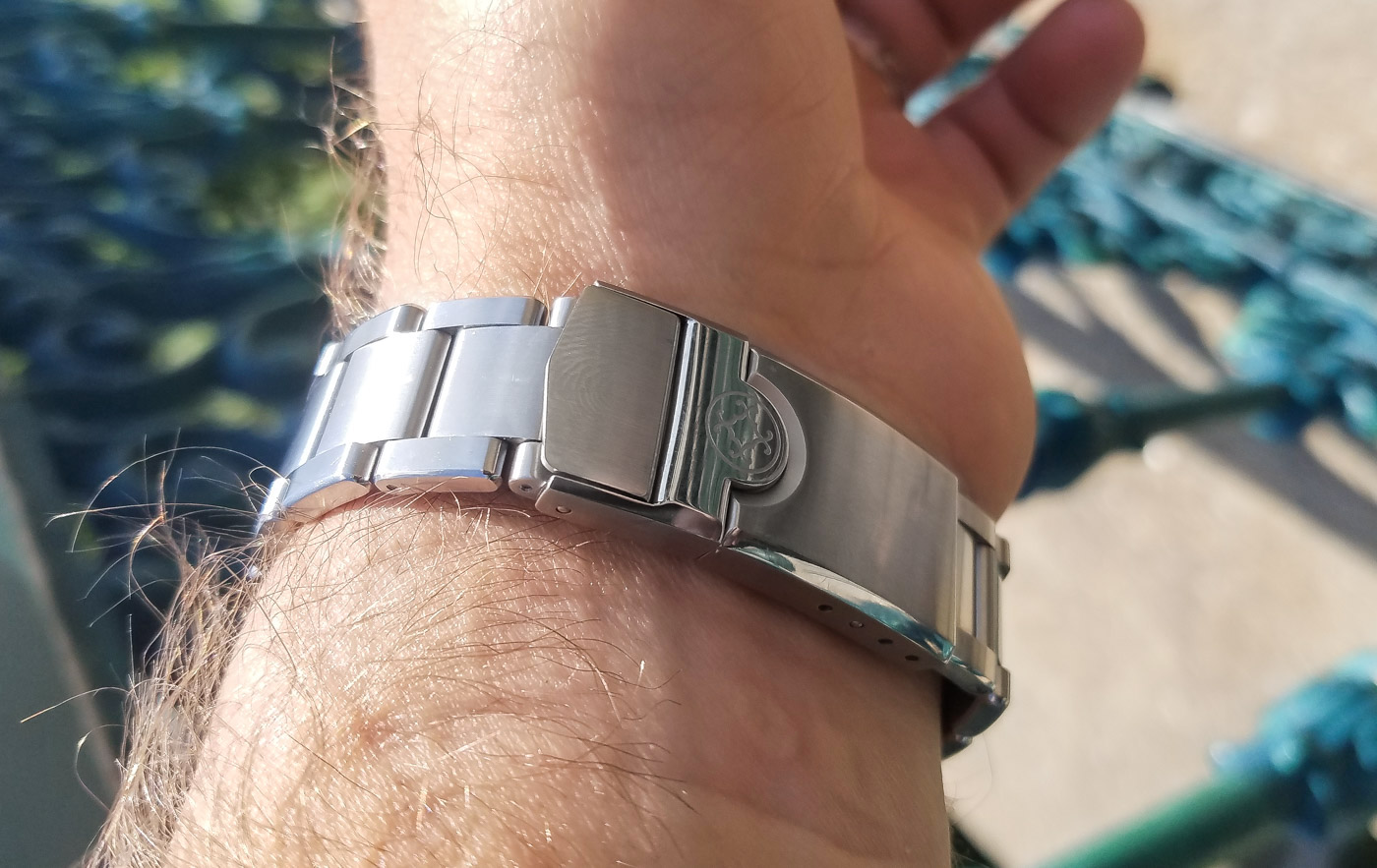
Case and Bracelet
The stainless-steel case of the Monta Atlas measures 38.5mm, with 47mm lug-to-lug distance, and a svelte height of 10.2mm. I’m sure there are some that would prefer a larger diameter, but for my 6.75” wrist, it’s absolutely spot-on for fit, while still having ample presence on the wrist. Personally, I find this to be a great size for daily wear; coupled with 150m water resistance, this is a watch you can easily wear day in and day out without concern. There are no crown guards, but the crown does screw down securely. The crown is on the small side and easy to use and manipulate, but I did find it to be less sturdy than I would have hoped for. The Atlas also features a flat sapphire crystal with 7 layers of anti-reflective coating. The AR coating works quite well at eliminating reflections and glare but is a fingerprint magnet. Flip the watch over and you’ll encounter more sapphire on the caseback: no superfluous text or engravings, just a sapphire crystal revealing the Sellita SW330-1 and its custom, decorated rotor. Simple and classy — I’m a fan.
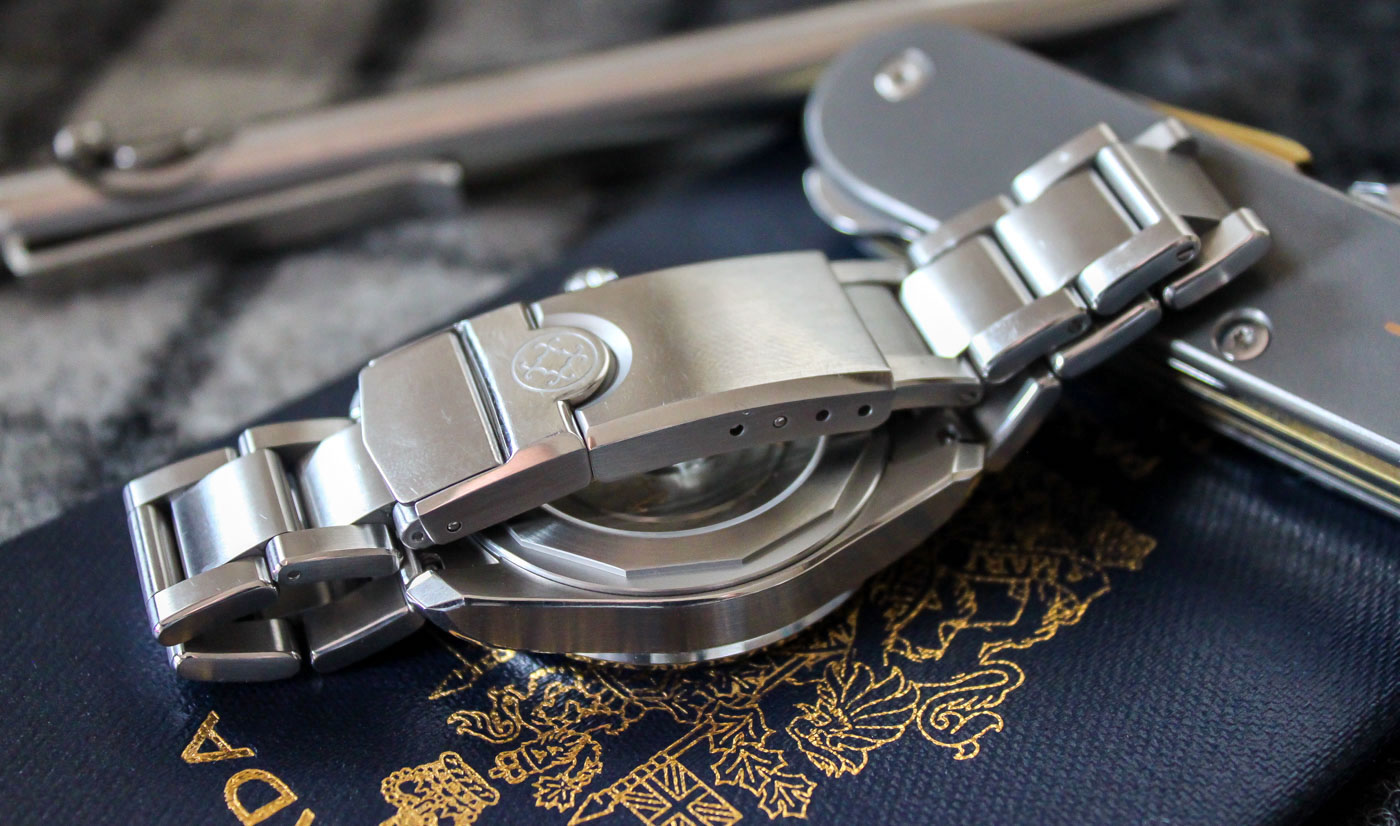
Let’s take a minute to talk about fit and finish. These are a couple of the most frustrating words for watch fans and reviewers alike due to how difficult they are to quantify. Sure, we can talk about brushing, polishing, beveling, and the like, but ultimately it often comes down to “I know it when I see it.” Take a look at the sharpness of the lines on the Monta Atlas, the classy mix of finishings, and all I can say is that it’s even better in the flesh. Regardless of price point, this is quality finishing, but considering the $1,950 sticker price, it really does stand out as exceptional.
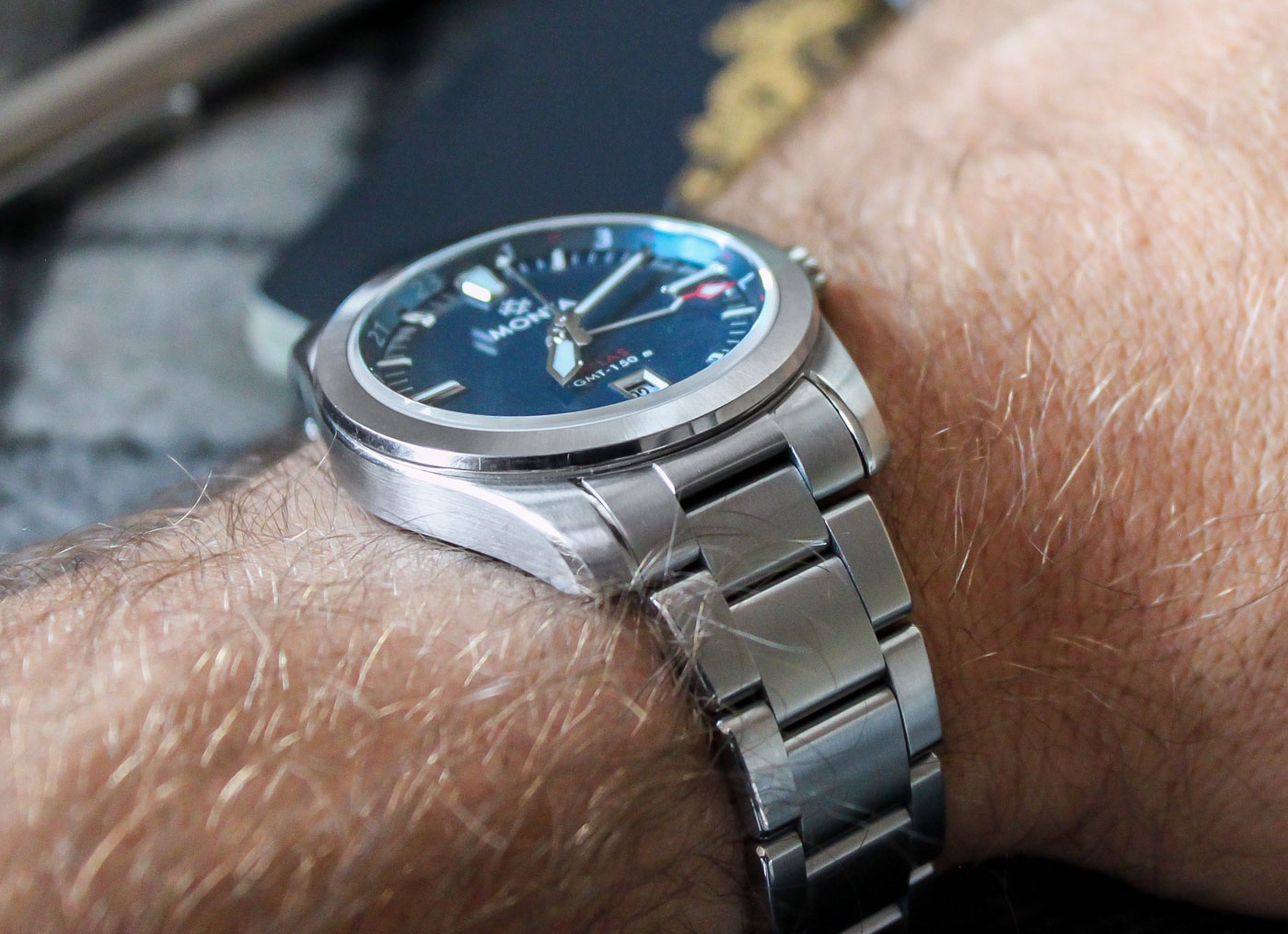
It’s worth taking a bit of time to talk about what Monta has done with this bracelet. At first glance, it’s a standard three-link bracelet with a machined (not stamped) clasp. Certainly true, but slip it on and that bracelet is buttery and molds to your wrist. It’s superb, full stop. Monta credits the fully articulating links for the added pliability and, um, butteriness. Take a look at the photo below to get a sense of what that means—essentially, each link can fully move in each direction. What’s more, the brand has since updated the bracelet with a more compact version of the adjustable clasp, making the watch even better on the wrist.
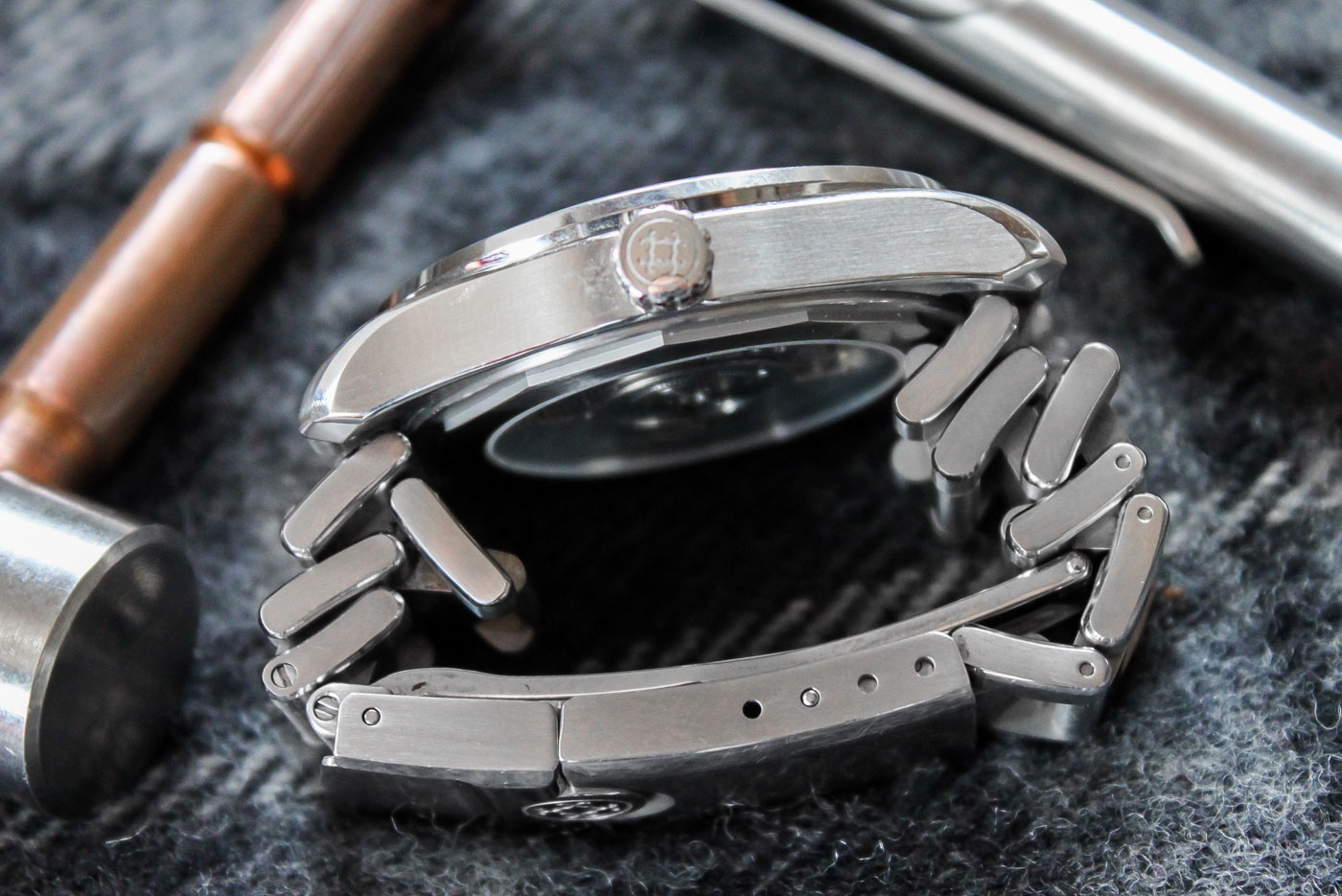
Alright, so the bracelet is comfortable, but a cheaply made bracelet can also be comfortable. There’s nothing cheap about the Atlas’s bracelet—finely brushed with high-polish beveling on the edges, a machined clasp with Monta’s logo taking the place of the keeper, and a satisfyingly positive engagement with zero play. As a guy who generally prefers bracelets, I’d be hard-pressed to wear this watch any other way. But, let’s not forget that Monta is from the same people behind Everest Bands (proprietor of luxury rubber straps for Rolexes), and as such, Monta ensured that all its models are fit with the straps offered by its sister brand. Whether you opt for an Everest strap or not, the Atlas does ship with a NATO-style fabric strap. I didn’t have one with my review model, but from the pictures and reports, it’s on par with the premium aftermarket options.
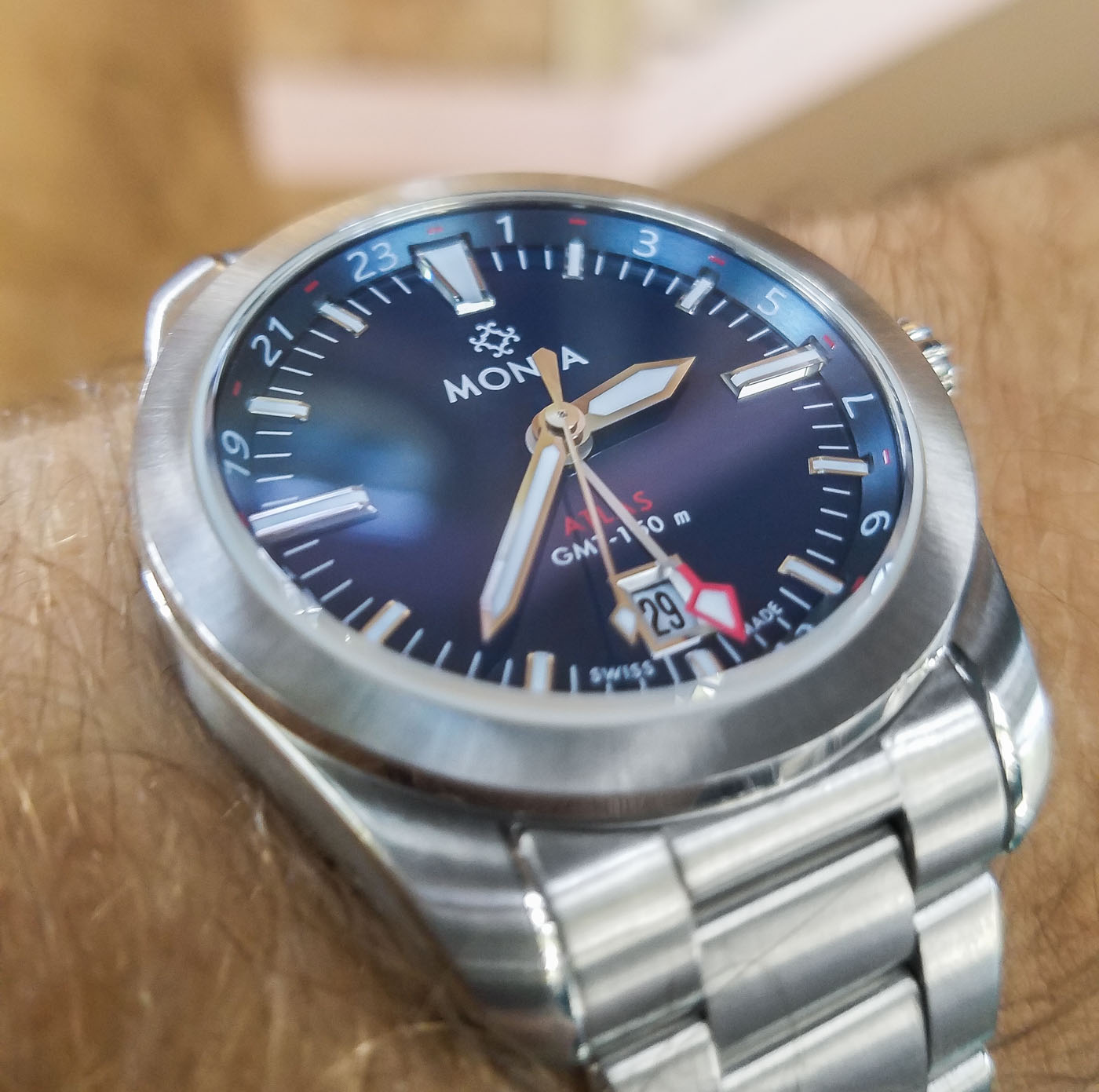
Dial and Hands
The Atlas is available in three colorways: charcoal gray, opaline silver, and blue. Something to note is that the images on Monta’s website show the blue as almost a deep turquoise, but in person, the green tones aren’t noticeable; I’ll call it oceanic since I’m struggling to find the right adjective to describe the color. Regardless of what you call it, the blue is deep, inky (almost wet), and simply entrancing. The blue continues along the rehaut where the 24-hour GMT markers are displayed, along with 12 red markers for even hours. Small pops of red are also present at 6 o’clock, spelling out Atlas, and on the GMT hand. One small quibble is that kerning between 150 and “m” at 6 o’clock seems slightly too wide. Additionally, I’m not a huge fan of red accents; mostly this is a personal preference, but it’s also because red is an easy default for many brands looking to add a bit of extra pizzazz. That said, I can’t deny that it works well with the blue dial, giving it just a bit of color pop and easily distinguishing the hour hand.
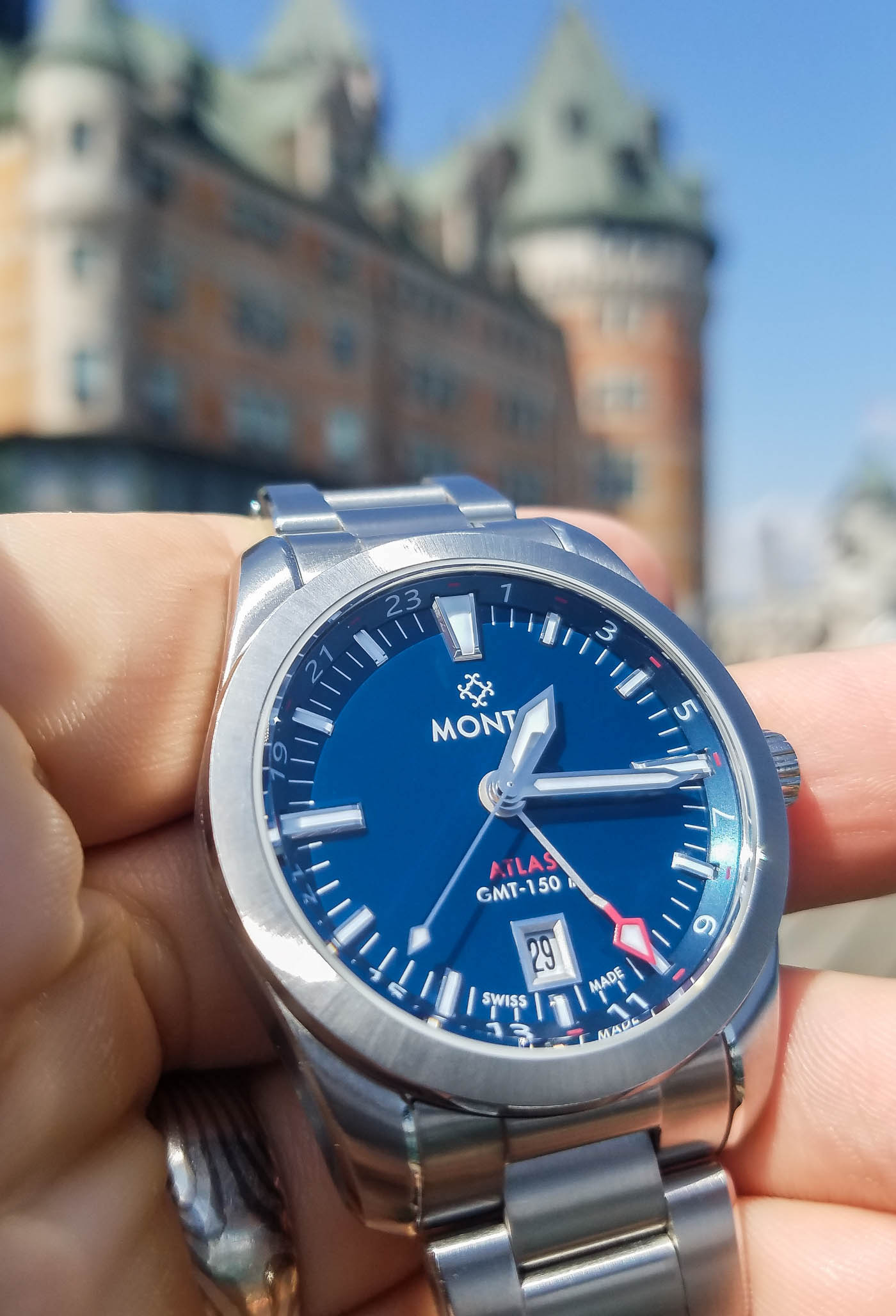
Monta opts for modified sword hands — a style that is consistent across their line, save for the staid Noble series. The hands are all highly polished, rhodium-plated, and sharp, but, most importantly, they’re balanced and well-proportioned. The hour hand is nice and broad, making it easily distinguishable from the minute hand. It’s an attractive, timeless handset that simply works and is a nice complement to the applied indices. The lume on the hands and indices is Super-LumiNova BGW9 and is generously applied, strong, and long-lasting. No complaints here. Finally, a framed white date window is placed at 6 o’clock. Personally, I prefer date windows, but a date-free option would look excellent, but the brand currently doesn’t offer any no-date options, so I won’t hold my breath.
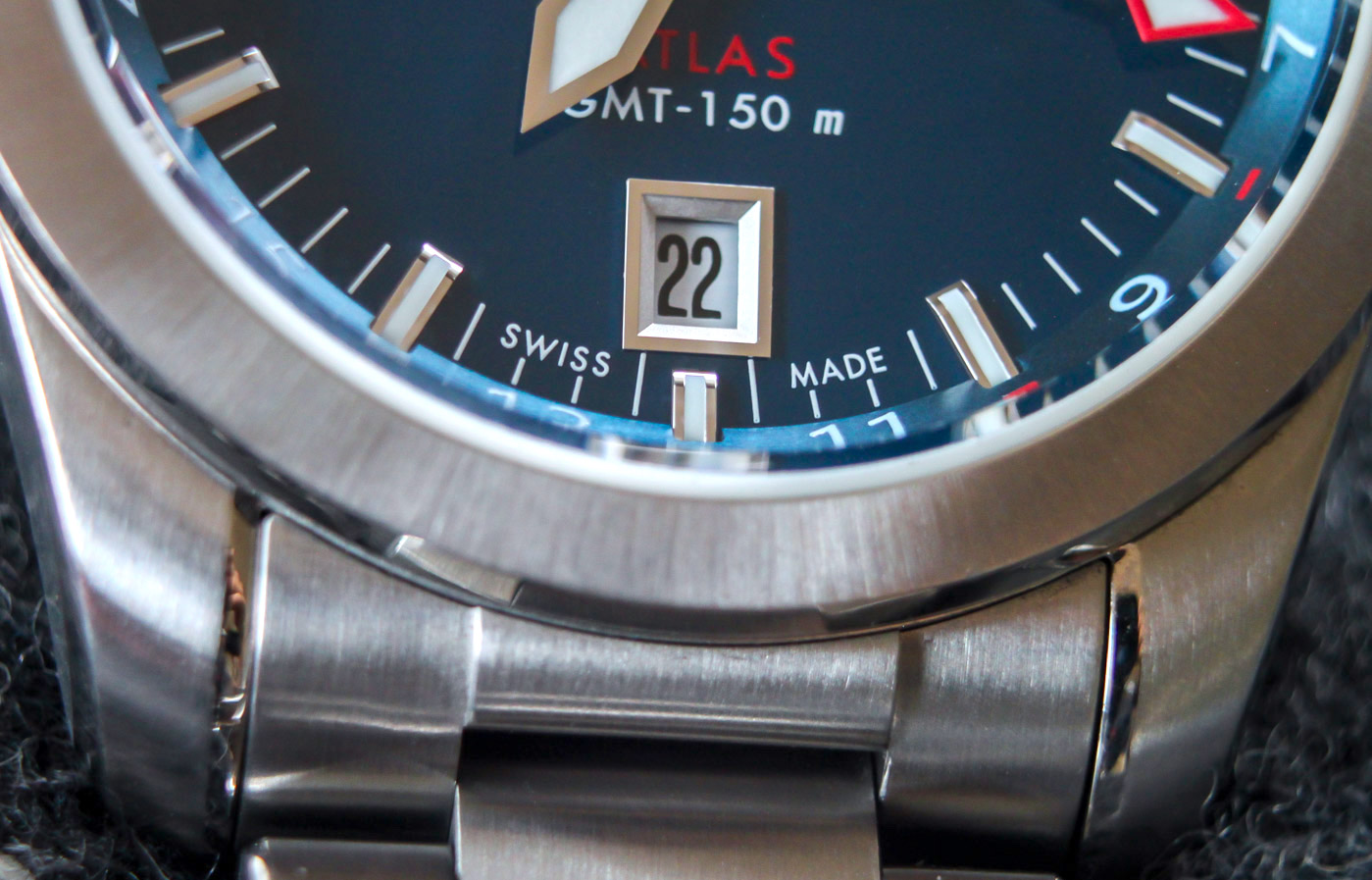
Now let’s get to the GMT hand. Monta wanted to produce a GMT hand that extended to the edge of the dial in order to align with the hour markers on the rehaut. The only problem is that it also wanted applied indices. To achieve both goals, they created a stepped GMT hand that rises above the markers at the tip. I can see the argument that this produces an unrefined look, but wearing it every day, it’s not something I noticed. Would I sacrifice the applied markers? Nope. The length of the hour hand? Nope again. So, the design was a good solution in my opinion. To be sure, many people love the bent GMT hand that Monta used.
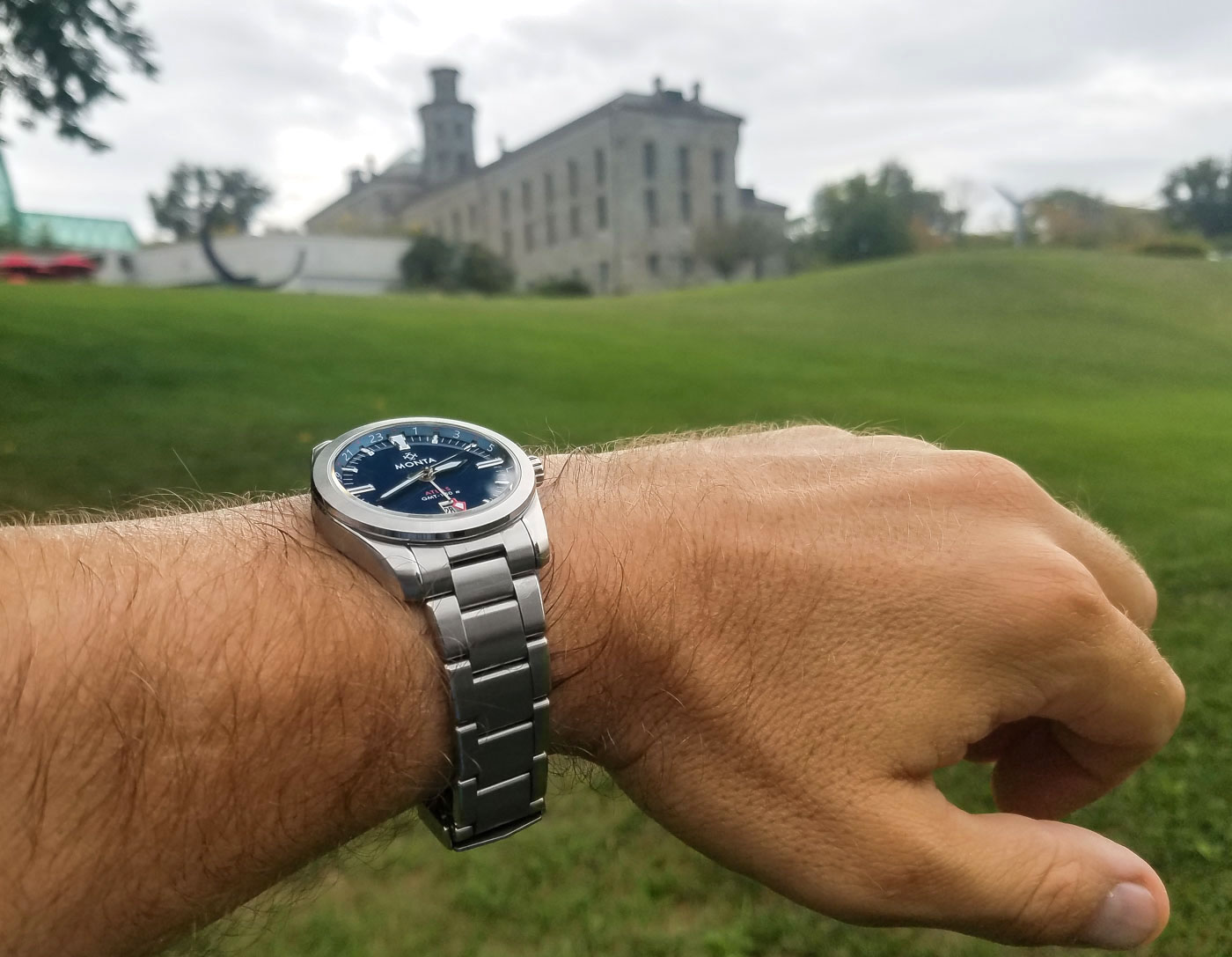 Movement
Movement
Powering the Monta Atlas I reviewed was the Monta Caliber M-23, which was a branded automatic Sellita SW330-1. Monta has in fact updated the Atlas with its branded Caliber M-23 to the newer automatic SW 330-2, which features an improved 56-hour power reserve at 28,800 vph. What sets this movement apart, of course, is the addition of the 24-hour GMT hand. The Sellita SW330-2 is a “caller” GMT rather than a “flyer” GMT. In other words, in the SW330-2, the GMT hand is controlled by the hour hand, meaning that when you land in a new city and move the hour hand forward, the GMT hand advances right along with the hour hand. You then have to take the additional step of advancing the GMT hand to the correct time. In contrast, in a flyer GMT, the local (12-hour) time is advanced in jumps by the crown (or pushers), while the 24-hour hand continues to track your home time. If you’re not familiar with the difference, your best bet is to watch a demonstration video on YouTube. The general thinking is that flyer GMTs are most useful if you’re traveling frequently and need to change the local time while keeping track of home time. On the other hand, caller GMTs are most useful for those keeping track of different time zones with the GMT hand (e.g., if you’re working with colleagues in different time zones). Ultimately, both types do the same thing, so it just comes down to whether you mind the extra 15 seconds or so it takes to set the time one way or the other.
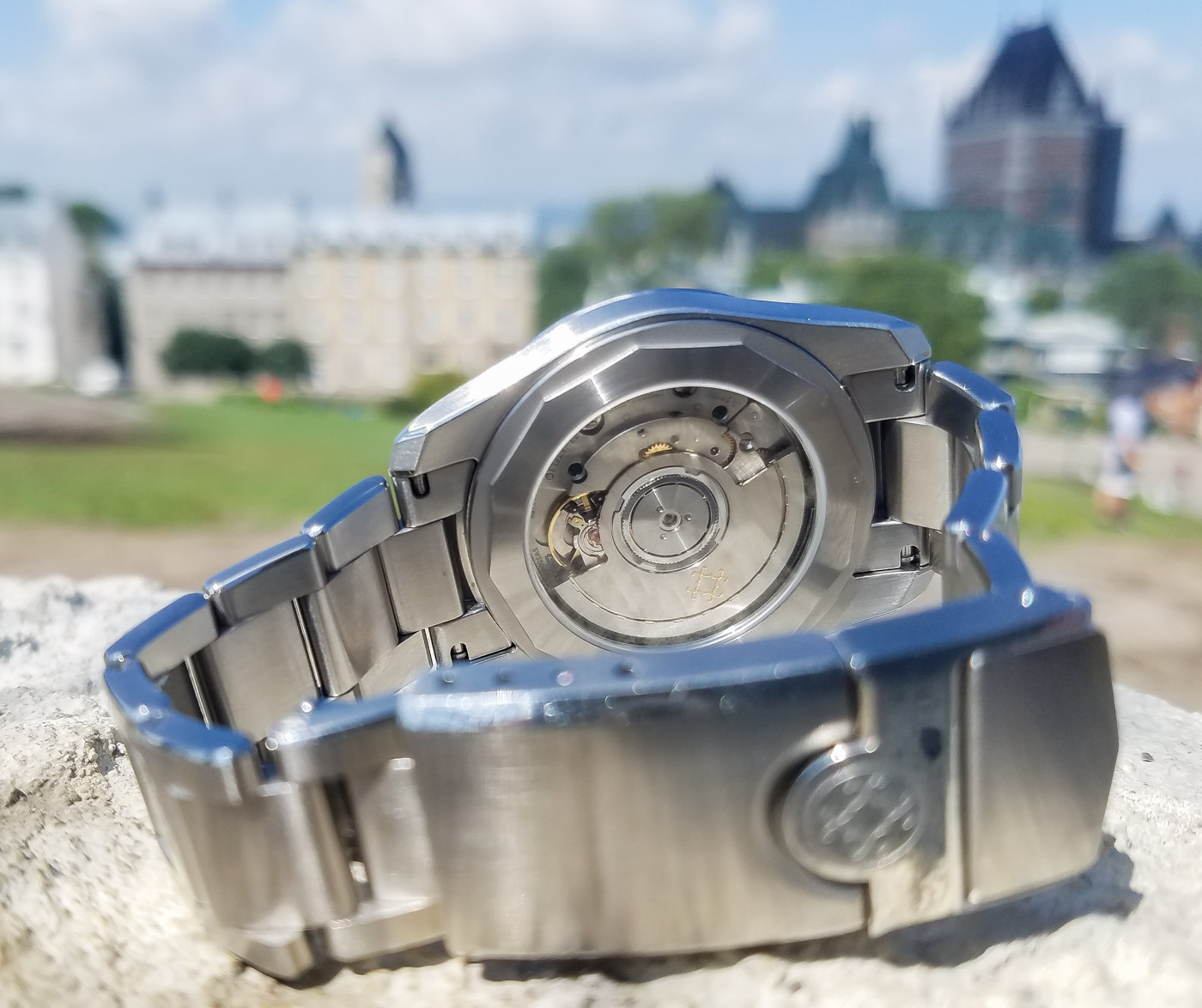
The timing for this review worked quite well as I received the watch just before heading across Canada to Quebec City. My personal habit is to set my watch to local time when the plane begins its descent. While it took slightly longer than the 10 seconds it would take to set a flyer GMT, setting the 12-hour hand to local time and the GMT hand back to home time took less than a minute. I’m not sure I would call myself a frequent traveler, but I tend to cross time zones several times a year, so a GMT function is nice to have and a difference of a few seconds in changing the time doesn’t affect my enjoyment of the piece in the least. Even if you’re not traveling often, it’s a useful complication when you use it, but one that’s easy to ignore when you don’t. I will say that there’s something comforting about glancing at the GMT hand when traveling and knowing what time it is for your loved ones. Or maybe I’m just sappy.
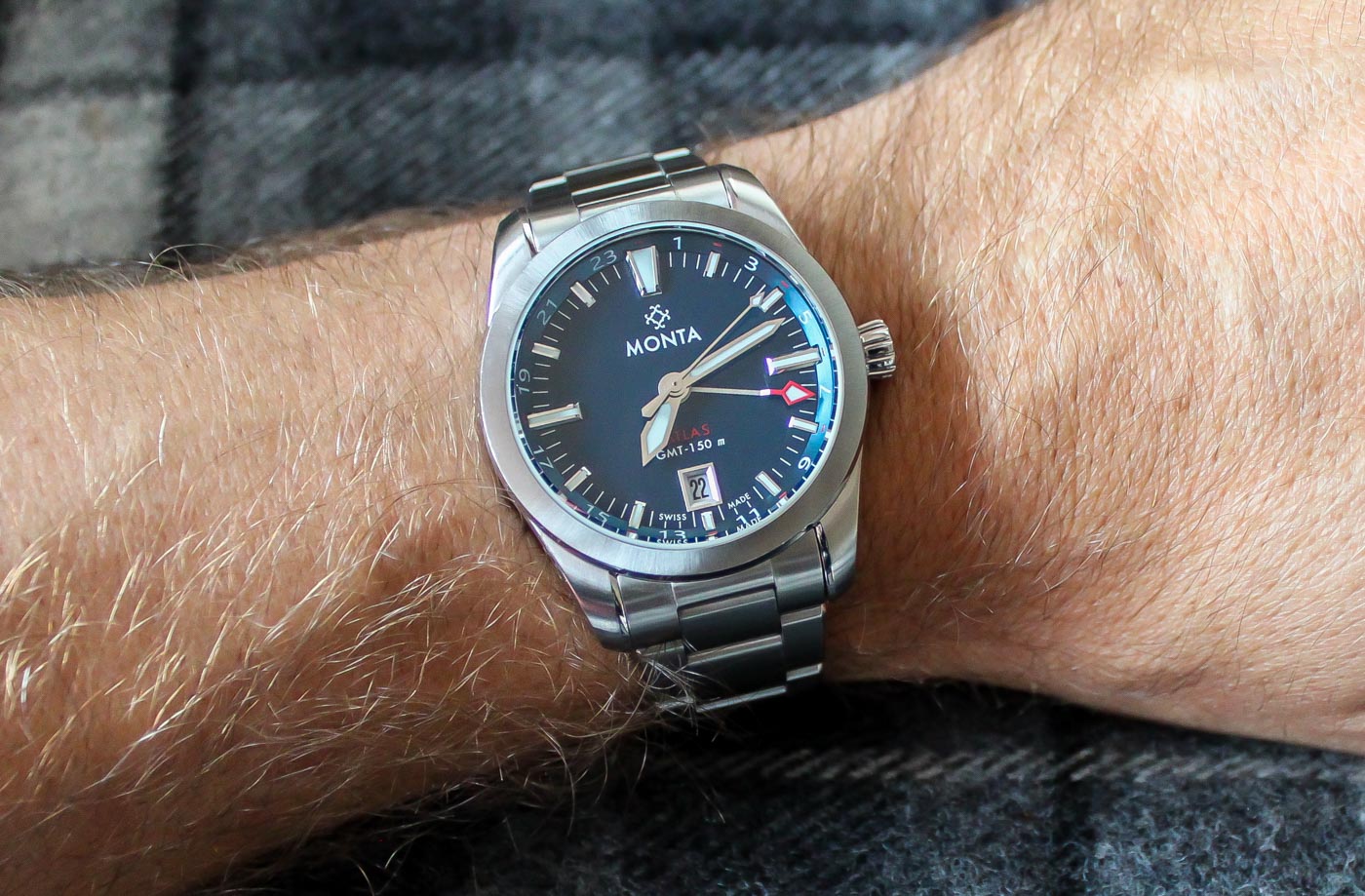
Final Thoughts
This was my first time wearing a Monta watch and I’m impressed. I mean really impressed. Many smaller brands—whether you call them boutique brands, microbrands, or independents—claim that they offer luxury quality at a fraction of the price (or some equally contrived tagline). And if we’re being honest, a great majority don’t even get close. Monta doesn’t explicitly make that claim, but the intention is clear: Make watches that rival the big boys at a more attractive price point. While I may be skewered for writing this, I see Monta aiming directly at customers interested in sports watches from Rolex and Omega. I’m not saying that Monta is producing equivalent watches at a fraction of the price (e.g., the Omega Aqua Terra GMT is $7,900 USD, compared to $1,950 for the Monta Atlas). That’s unfair to everyone, especially when you consider movements. What I am saying is that Monta is producing watches, including the Atlas, that are classically styled, well-proportioned, and extremely well-finished for the price point. We all recognize the law of diminishing returns in watches—twice the money does not get you twice the watch—but for a quarter of the price of an Omega (or just over a tenth of the $15,650 USD you need to fork over for Rolex’s non-sport GMT, the Sky-Dweller), you’re getting one hell of a watch.
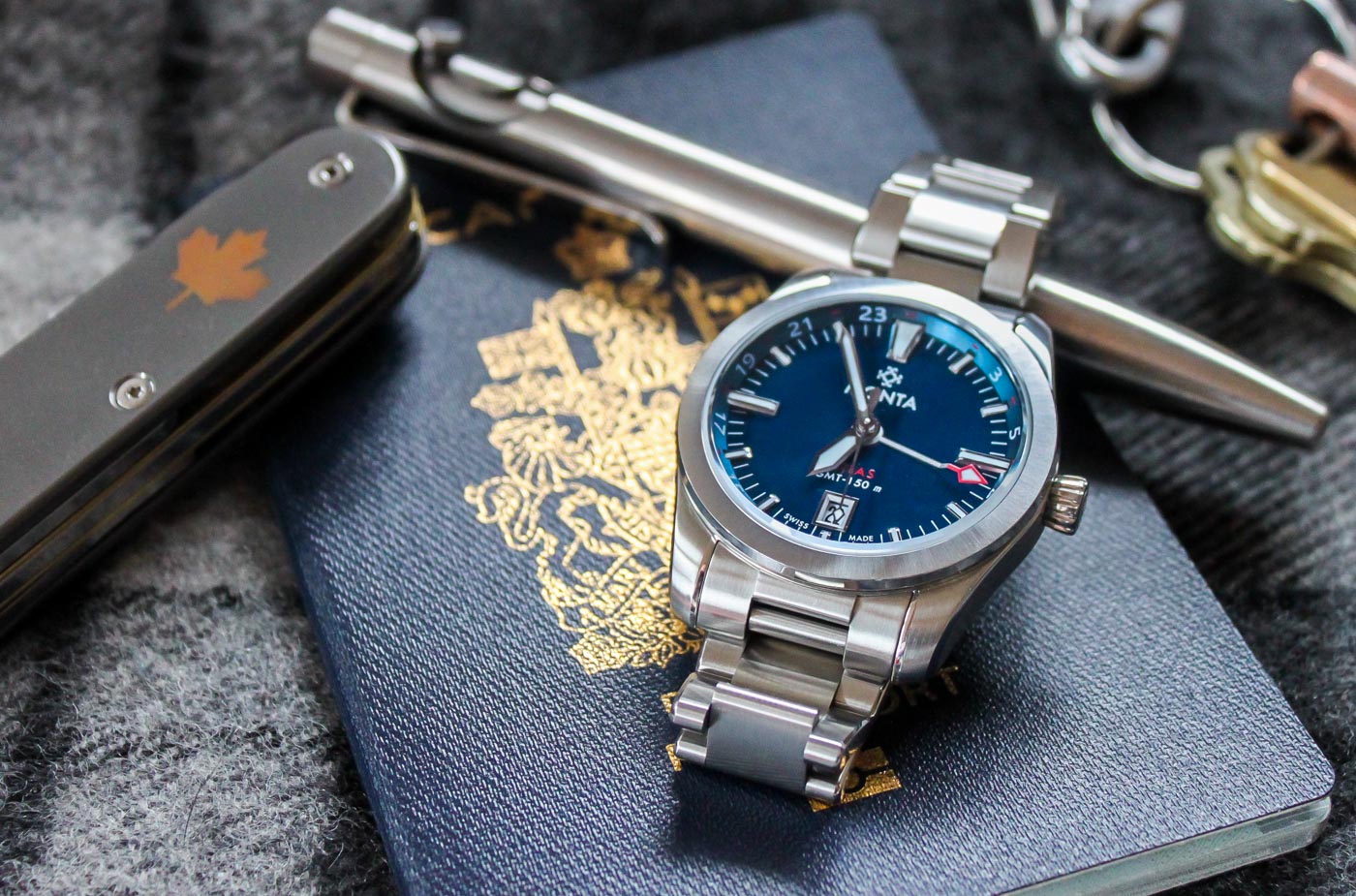
The close association between Everest Bands and Rolex is readily apparent across Monta’s lineup—not in a derivative way, but more in a general ethos. Perhaps it’s the maturity of design, the carefully curated lineup, or simply the spot-on proportions of the watches (seriously, from the case to the markers to the hands, the proportions are excellent), but I see Monta evoking Rolex in the sense of creating designs that work well across many situations. I think of them as classic Go Anywhere, Do Anything watches that are durable and functional, but have enough class to wear with a suit and tie, or dressed down with a t-shirt and flip-flops. Pick a design you like (diver, field watch, sport watch) and simply wear it day in, day out for the next decade or two without a second thought.
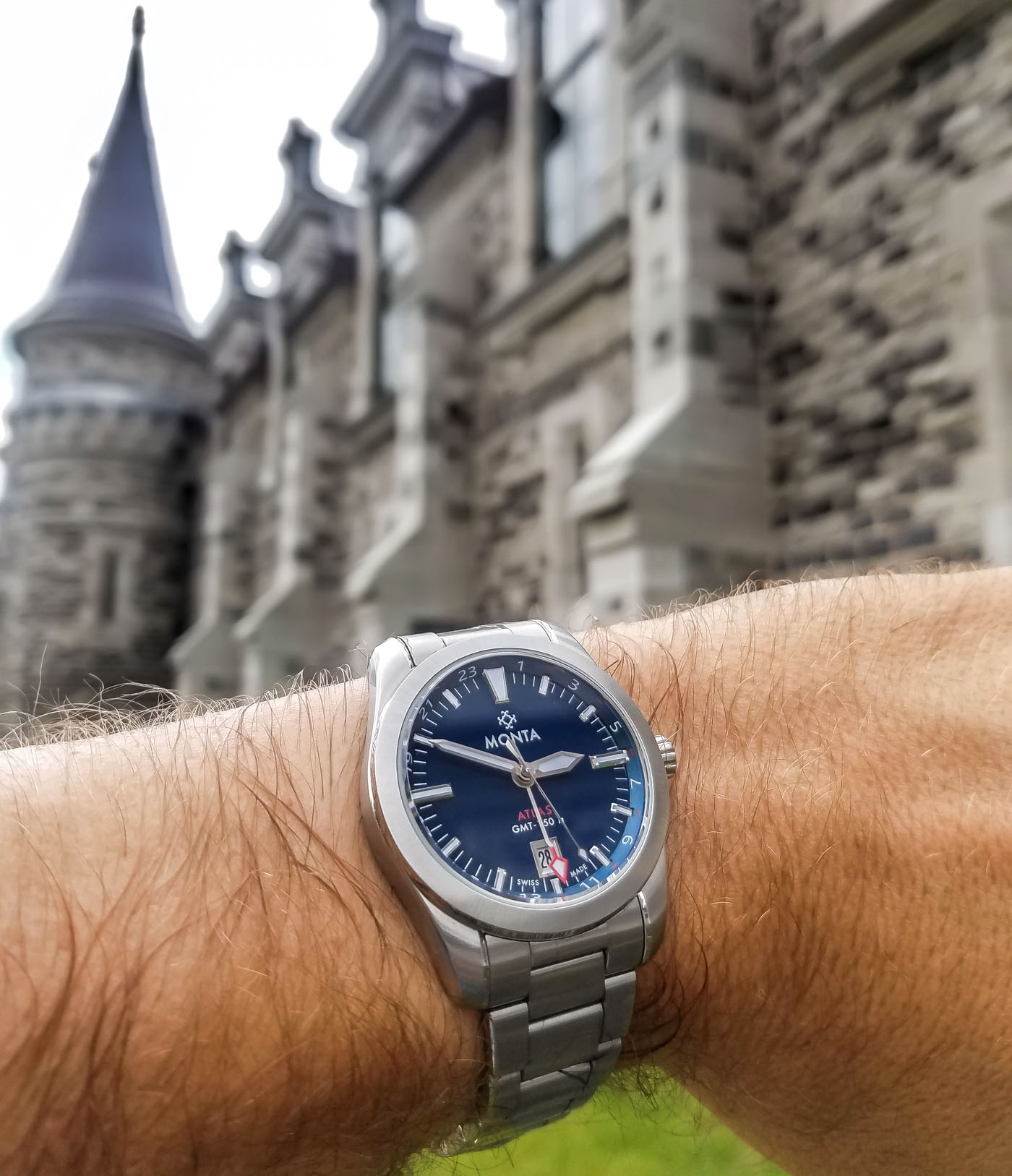 The easiest way to express my opinion on this watch is to note that after returning my review watch, I was so impressed I purchased a Monta for myself. Since I don’t travel extensively, but do spend an inordinate amount of time in the field, I opted for the Triumph (a field watch that shares a very similar case design and aesthetic to the Atlas). I have to say, I was torn between the Triumph and the Atlas since the blue on the Atlas is oh-so-nice, as is the simplicity of the dial and the there-when-you-need it GMT Function. In my ideal world, I’d love to see a watch somewhere in the middle: an Atlas without GMT or a Triumph without Arabics (which is essentially what the brand ended up doing when it released the Noble in 2020, after I had purchased and properly bonded with my Triumph). Regardless, Monta won me over.
The easiest way to express my opinion on this watch is to note that after returning my review watch, I was so impressed I purchased a Monta for myself. Since I don’t travel extensively, but do spend an inordinate amount of time in the field, I opted for the Triumph (a field watch that shares a very similar case design and aesthetic to the Atlas). I have to say, I was torn between the Triumph and the Atlas since the blue on the Atlas is oh-so-nice, as is the simplicity of the dial and the there-when-you-need it GMT Function. In my ideal world, I’d love to see a watch somewhere in the middle: an Atlas without GMT or a Triumph without Arabics (which is essentially what the brand ended up doing when it released the Noble in 2020, after I had purchased and properly bonded with my Triumph). Regardless, Monta won me over.
Necessary Data
>Brand: Monta
>Model: Atlas
>Price: $1,950 USD
>Size: 38.5 mm wide, 10.2 mm thick, 20mm lugs, and 47mm lug-to-lug distance.
>When reviewer would personally wear it: Anytime, but especially when traveling.
>Friend we’d recommend it to first: Someone looking for an everyday watch that appreciates fit, finish, and comfort.
>Best characteristic of watch: Well-proportioned and eminently comfortable.
>Worst characteristic of watch: Would love to see a non-GMT version of this exact design (without red accents).

